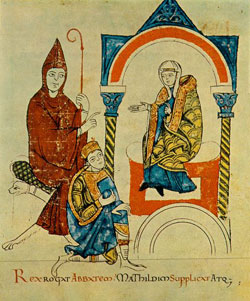
Feastday: April 29
Patron: Against fever
Birth: 1024
Death: 1109
Benedictine abbot and one of the most influential men of his era. He was born the eldest son of the Count of Semur, France and entered Cluny Abbey, France, at the age of fifteen. He was ordained at twenty, and elected abbot at twenty five. Hugh succeeded St. Odilo in this office. He attended the Council of Reims, supported Pope St. Leo IX's efforts at reform, and in 1057 served as a papal legate negotiating a peace between King Henry IV and King Andrew I of Hungary. In 1059, he aided Pope Nicholas II and then Pope Gregory VIII. Hugh mediated the feud between the Holy See and King Henry IV Cluny, then the largest church in Christendom, was blessed by Pope Urban II. Hugh also founded a hospital for lepers and preached the First Crusade. He died at Cluny having served as abbot for six decades, and was canonized in 1120.
For the later abbot with the same name, see Hugh II of Cluny.Hugh (13 May 1024 – 28 April 1109), sometimes called Hugh the Great or Hugh of Semur, was the Abbot of Cluny from 1049 until his death. He was one of the most influential leaders of the monastic orders from the Middle Ages.
Biography
 The interior of the abbey of Cluny
The interior of the abbey of Cluny
Hugh was the son of Count Dalmas I of Semur and Aremberge of Vergy; his father wanted him to be a knight and a secular leader. At the age of fifteen, he took his monastic vows and later became an abbot. Abbot Hugh built the third abbey church at Cluny, the largest structure in Europe for many centuries, with funds provided by Ferdinand I of León. He was the driving force behind the Cluniac monastic movement during the last quarter of the 11th century, which had priories throughout Southern France and northern Spain.
Political influence
Hugh's relationship to Ferdinand I and Alphonso VI of León and Castile, including the release of Alphonso from his brother, Sancho's prison. His influence upon Pope Urban II, who had been prior at Cluny under Hugh, made Hugh one of the most powerful and influential figures of the late 11th century.
As the godfather of the Holy Roman Emperor, Henry IV, he also played a role as a mediator during the conflict between Pope Gregory VII and Henry IV, though he was not successful. Additionally, he was an active diplomat to Germany and Hungary on behalf of the church. He died on the 28th of April, 1109. Many of his relics were pillaged or destroyed by the Huguenots in 1575.
After Clementia of Burgundy was married, she gifted Hugh the Flemish monastery of St. Bertin. This act spread the Cluniac order north of the Loire and initiated monastic reform in Flanders.
His feast day is April 29.





